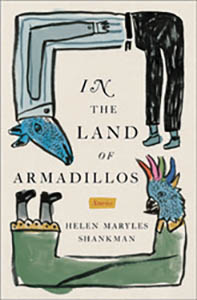
When it comes to the literature of the Holocaust, there can sometimes appear to be a glut of fiction written by those distant from it, too often revisiting the same bleak terrain of atrocity with the same tropes and sentiments. Helen Maryles Shankman’s book, by contrast, stands out as one of the most original and consistently captivating short story collections to have appeared in recent years.
Set in the Polish hamlet of Wlodawa—with the exception of the volume’s brittle coda which takes place in the 1980s—each of the eight stories comprising “In the Land of Armadillos” (Scribner, 2016) proves too captivating and resonant to single out one from the rest. Indeed, experienced together, the collection reads as a sophisticated orchestration. So tightly interwoven are its themes, characters and grim events that it is hard to imagine any one apart from the others. These are strange stories in which the miraculous perseveres amid the monstrous as the memorable protagonists struggle to cope with horrific realities. A collection that depends on the reader’s acceptance of historical brutalities blended with the paranormal would seem an unlikely formula for success, yet “In the Land of Armadillos” is an absolutely dazzling triumph.
In the title story, Shankman riffs intelligently and hauntingly on the demise of the famous visual artist and writer Bruno Schulz, murdered at the hands of an S.S. officer who sought revenge for the slaying of his own “pet Jew.” Though other writers—most notably Roberto Bolaño, David Grossman and Cynthia Ozick—have visited Schulz’s art and tragic death before, Shankman holds her own in rendering a Jewish muralist whose art is brimming with lyrically and morally potent allegories whose meaning eludes the understanding of his brutish captor.
With each subsequent narrative, the moral and psychological structure of “In the Land of Armadillos” deepens and evolves into greater intricacy. Though unsparing in its depiction of atrocity, the most genuinely shocking developments are those that delve deep into the mysteries of betrayal, most conspicuously of Jews by their Polish friends and neighbors. Shankman imaginatively turns characters and events around and around, a multifarious reality encompassing the perspectives of Jews, Poles and even those of Germans—most strikingly the perceptions of the Nazi Kommandant Reinhart, a lover of the land and agrarian life appointed as the Reich Regional Commissioner of Agricultural Products & Services. Immune to the nonsense of racist theory, he likes to imagine that he presides over “his own Shangri-La, insulated from the insanity consuming the civilized world[…] except for the smell that floated in sometimes from the camp at Sobibór, only six kilometers away, a smell that didn’t belong among the fields, the farmers, the forests and the plowed earth.”
Shankman’s skill for description paints the setting in brilliant detail. Her capacity for deftly merging horror and natural beauty throughout is concisely captured in her depiction of the aftermath of a massacre: “When the first chilly breath of nighttime riffles through a young girl’s hair, even the sun shivers, withdraws its warmth, and slinks away.” Many stories reward with ironic twists and indelible surprises—Golem’s true identity; a heated argument about the fate of the world between a 12-year-old boy and the Messiah. Others are rendered in spare realism, exemplified by the chilly narrative of a Nazi’s son scouring the countryside of Wlodawa in search of atonement. Though each narrative revisits the same topos, Shankman constantly surprises us, outwitting us by defamiliarizing characters and scenes we thought we had fully grasped again and again. Every story presents its own mythical aura, lyricism and horror. Even animals are given their due, as with a remarkable tale about a hidden child’s poignant and eerie friendship with a feral dog in “The Jew Hater.”
“A Decent Man,” the collection’s penultimate and perhaps most ambitious story, explores many of the preceding events through the perspective of Reinhart, who has the audacity to imagine that he has managed to preserve his humanity and integrity throughout the war—at least until certain events overtake him. In the story’s ruthless denouement, his self-justifications are stripped bare, revealed as the dangerous illusions to which he, like so many others, pathetically cleaved past all hope of salvation. In a book brimming with myths and fantasy, Reinhart’s fallacy emerges as the biggest fairytale of them all.
For those interested in the growing corpus that has come to be known as “Second-Generation” Holocaust literature, it is worth noting that many of the stories are based on the real events endured by Shankman’s parents, grandparents, uncles and aunts who lived through the Holocaust, whom she honors by distilling their harrowing memories into truly transformative literary art. “In the Land of Armadillos” is a singularly inventive collection of chilling stark realism enhanced by the hallucinatory ingredient of top-drawer magical realism, interrogating the value of art, storytelling and dreams in a time of peril and presenting hard truths with wisdom, magic and grace.
By Ranen Omer-Sherman













